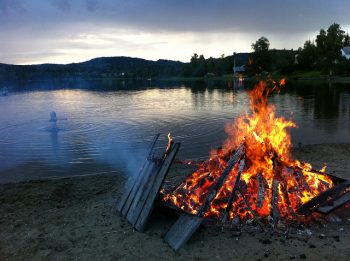Happy Sankthansaften! Posted by Bjørn A. Bojesen on Jun 23, 2017 in Holidays, Traditions
Hvorfor må det alltid regne på sankthansaften? (Why does it always have to rain on Midsummer’s Eve?) That is the question many Norwegians ask themselves on June 23rd, and for lots of communities in Norge, this year is no exception. Still, most people trosser været (disobey the weather), don their regnklær (rainwear) and gather in the early evening to enjoy the warmth from the local sankthansbål (the Midsummer’s Eve bonfire).
Since Kari has already written about the origins of Sankthans – which literally means ”Saint John” and is (in part) a leftover from the days when Norway was Catholic – I’ll focus on the practical sides of this ancient Midsummer celebration, which some Norwegians know as Jonsok [YONNsock].
The big attraction of kvelden (the evening) is bålet (the bonfire). Bonfires are lit everywhere in Norway on this date, and a community has to be extremely small in order not to have one. The sight of flammene (the flames) blazing against a mountain backdrop – and the immense varme (warmth) from bålet – can be an amazing experience, no matter the amount of regn (rain).
The fire is a remnant of a pre-Christian ritual which was undertaken to expell onde makter (evil powers) – such as hekser (witches) – from the community. In many places in Norway, people still burn a heksedukke (witch doll) on this evening. It is a bit scary for barna (the children), so the parents must always have a good explanation at hand. 🙂
In some communities, the sankthansaften event is organized by an idrettslag (sport’s organization) or charity who charges an entrance fee. They organize various fun games and konkurranser (competitions). People chat and drink kaffe (coffee) and brus (≈ lemonade), while the kids are busy eating so many pølser (sausages) and is (ice-creams) as they can stomach on this very special evening.

Build vocabulary, practice pronunciation, and more with Transparent Language Online. Available anytime, anywhere, on any device.




